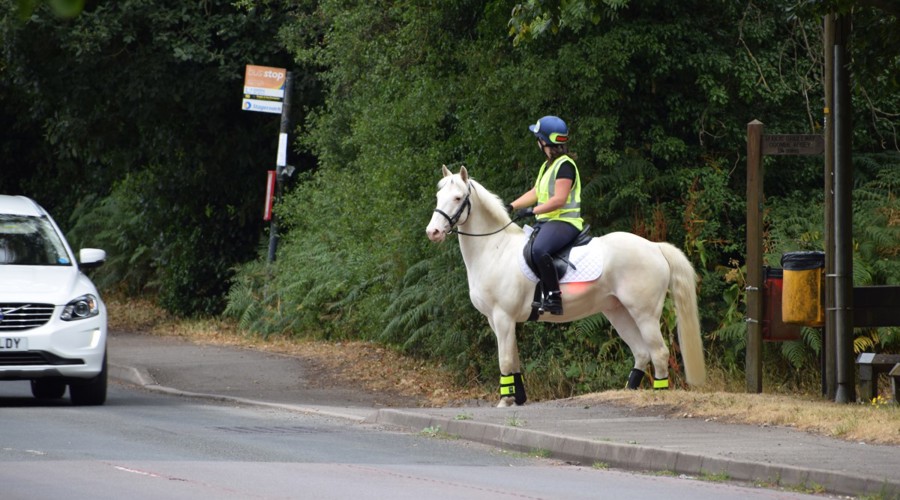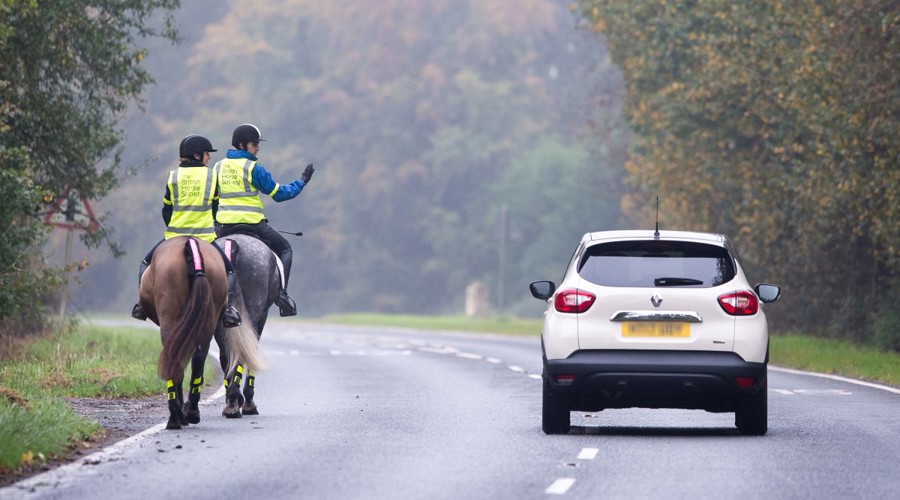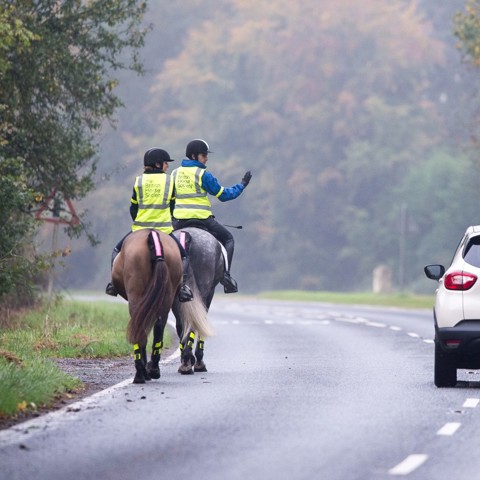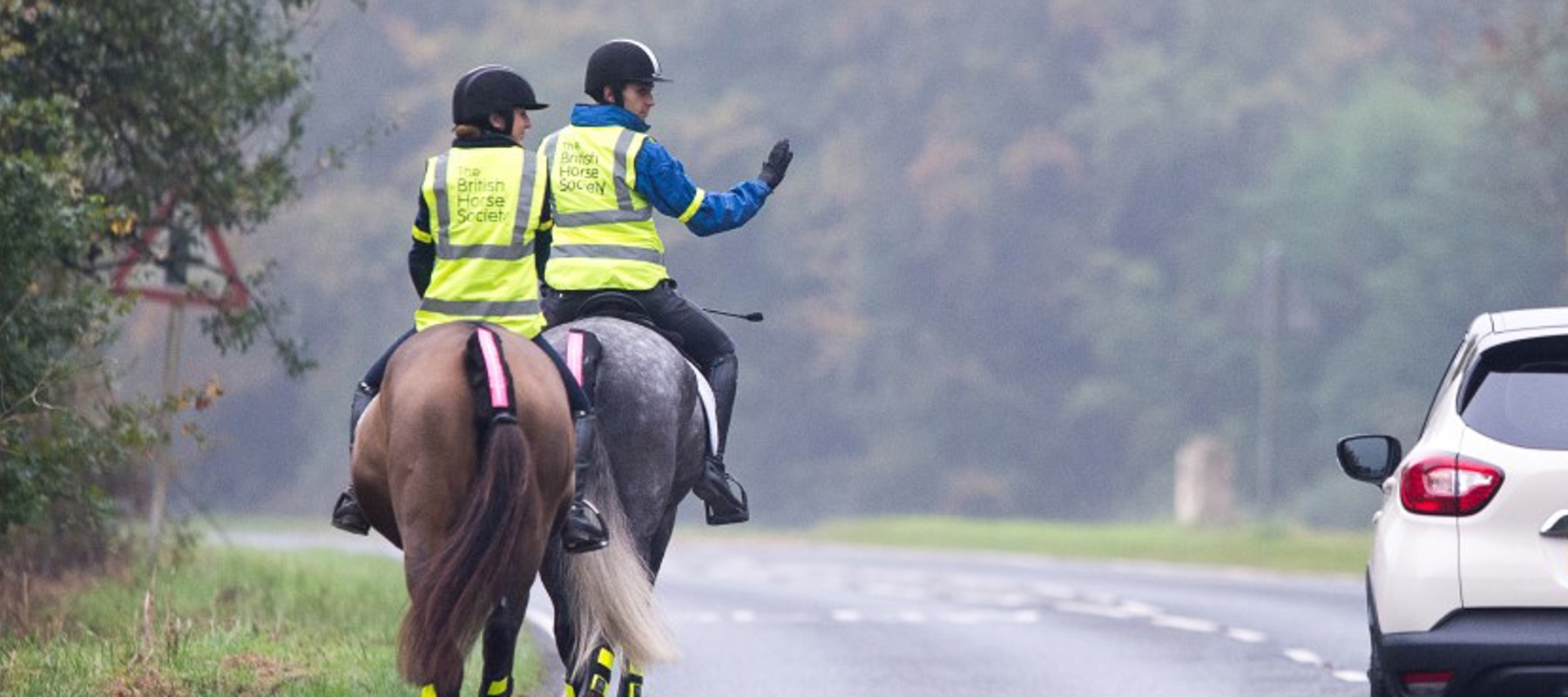It’s vital to always pass horses slowly and with plenty of room.
Equestrians have the same right to be on the road as motorists or any other user group. Understanding, respect and consideration by all road users is required to ensure road safety for everyone.
We advise all equestrians and road users to familiarise themselves with the Highway Code.
The Highway Code was updated on 29 January 2022. The BHS have worked hard over the last three years; lobbying and collaborating with Cycling UK, DVSA, Living Streets and the Department for Transport (DfT) to suggest the much-needed Highway Code improvements and to represent equestrians in the review.
What should you do if you see a horse on the road?
If I see a horse on the road, then I will:
- Slow down to a maximum of 10mph
- Be patient, I won’t sound my horn or rev my engine
- Pass the horse wide and slow – at least two metres
- Drive slowly away
Feral or semi-feral ponies found in areas such as the New Forest, Exmoor and Dartmoor require the same consideration as ridden horses when approaching or passing.
 play-circle
play-circle
Watch
Do you know how to pass a horse?
What else can you do?
- Be prepared to stop if necessary.
- Look out for hand signals – stop or slow down if asked – this is for your own safety as it is others.
- If a rider or carriage driver is signalling to turn, wait patiently for them to complete their manoeuvre before continuing your journey.
- If you think the horse looks nervous – they may be stopped, look tense, “jogging” or moving sideways – please stop, turn off your engine and allow the horse to pass you. Please don’t start your engine or move off again until the horse is well clear of the rear end of the vehicle.
- If passing a horse from behind - heed the rider, handler or carriage driver’s signal. Only pass if safe to do so. If the horse looks nervous or the person in control of the horse is having difficulty - leave plenty of space between you and the horse and wait patiently for the horse to be under control, or for them to pull over to a safe place to pass.
- If a road is narrow and there is not enough room to pass safely as if passing another car, please approach slowly, or stop, and allow the equestrian to find a safe place off the road where you can pass safely.
- It may not always be possible for a rider or carriage driver to pull into a safe passing space. If you meet a horse head on, it can be easier for the driver to reverse to a safe passing space. If you are behind a horse, please wait patiently until there is a safe place to pass.
- Please be patient. Most equestrians will do their best to reassure their horses and will allow you to pass as soon as safe to do so.
- The safest place for the rider’s hands is on the reins, so they may only be able to nod their head as thanks to you –please be assured they are very grateful for your consideration.
- Look out for equestrian road signs – these signs indicate you are likely to encounter a horse on your journey.
Dead Slow VR 360 Film
Since the launch of The British Horse Society’s (BHS) Dead Slow campaign, we have been working with many organisations to educate drivers on how to pass horses safely. The Dead Slow campaign messages have been designed to influence drivers and change their behaviour around horses.
The BHS has launched a virtual reality film to show drivers what it’s like to be riding a horse when a car passes too fast or too close. Viewing the film gives you the alarming first-hand experience of being on a horse as a vehicle passes too close. The film also demonstrates what drivers experience when approaching a horse in a vehicle that is going too fast.
 play-circle
play-circle
Watch
How does it feel when a vehicle passes to close or fast?
Understanding horses
Horses are flight animals – in the wild, horses are prey animals, and this instinct is still present in domesticated horses. Their usual response to danger is flight. Horses can be unpredictable, even though most are well-trained and trust their handler. Unexpected or loud noises can startle a horse, just like they can a human.
Hearing – A horse has three primary hearing functions:
- Detection (hearing the sound)
- Location (the direction the sound is coming from)
- Sensory (identify the source of the sound)
A horse’s ears can turn to listen in front, to the side, and behind them. Horses have a greater range of hearing compared to humans. A horse can hear higher frequencies over 33kHz, a human can hear up to 20kHz. Horses may not be able to hear the lowest frequencies audible to a human.
Advice for Large Vehicles
Horses can be nervous around large vehicles. If you see a horse, proceed with caution and be prepared to stop and turn off your engine. In many cases, stopping with your engine off is the safest option, allowing the horse to pass your vehicle. Do not start your engine or move off until the horse is well clear of your vehicle. You may need to wait until the horse can be moved off the road to pass safely.
Large vehicles such as lorries, agricultural vehicles, vehicles towing trailers or machinery can be daunting to a horse, particularly if they have not encountered this type of vehicle before. These vehicles can be unfamiliar and intimidating to a horse as they are bigger than other vehicles such as cars, the noise may startle them with couplings or moving machinery, or the air brakes can cause alarm.
Gritting lorries and horses
chevron-down
chevron-up
Encounters between horses and gritting lorries are fairly infrequent, however the size, lights and noise from the spreading equipment is unfamiliar to horses and may cause them to react in a way that could be challenging to the rider.
What should a gritting lorry driver do if they see a horse?
- Stop
- Turn off the gritter, spreading machinery and lights
- Allow the rider to pass the lorry, or find a safe place to move off and away from the road
- Once the horse has passed or is off the road, start your engine but not the lights or spreader and drive slowly past allowing plenty of space. Be prepared to stop again if needed
- Reinstate your lights once you are past the horse
Prevention is key - it may take a few moments but if there is an accident requiring emergency services or vet you will be delayed even longer
What should an equestrian do if they see a gritting lorry?
- Familiarise yourself with the gritting status of roads you use regularly and sign up to any notification service provided by your Highways Authority – this will allow you to lower the risk of meeting gritter lorries.
- Move off the main carriageway and as far away from the gritting area as possible. Gritter lorries cannot miss sections of road in the salt distribution as to do so risks dangerous ice. Except on wide roads, the salt is sprayed over both lanes but not beyond the kerb.
- If you think your horse is likely to react when encountering a gritter lorry, familiarise yourself with the driver instructions above, and follow the below advice.
- If you see that a gritter lorry is behind you, look for somewhere safe to step off the main carriageway. Turn your horses head so that they can see the source of the noise/flashing lights.
- Once you have done so, signal to the driver that your horse is settled; they should then pass you slowly.
- We recommend wearing appropriate hi-vis clothing when riding out, this helps make you visible and conspicuous to all drivers. See the Transport Research Laboratory Report – Conspicuity of Horses and Riders on Roads.
Buses
chevron-down
chevron-up
Follow this link for advice on safely passing horses


